Travel photography is more than just taking stunning pictures. It is meant to inspire, educate, and tell a story. It becomes the duty to invite the viewer into the picture and make him wish to be part of it by capturing and recording the far-off location in one frame. The world is not limited to the space around us; it is much larger, more exquisite, and has many distinctions.
Reliable power resources in photography are essential in a modern, fast-paced world with an even faster, rejuvenating, and sustainable environment. Jackery Explorer Portable Power Stations have a specialty over the other options for portable power supply, with due regard to the environment. That includes being lightweight and carrying easily, offering the power backup required for charging shooting equipment outdoors.
What Is Travel Photography?
Travel photography is a photograph taken while one is traveling. It is a combined form of photography that includes many branches, such as street photography, architectural photography, food photography, landscape photography, and adventures. First, travel photography was clicked by George Eastman in 1888.
Good travel pictures require creativity and perspective. They speak the story from your perspective. More than a click, they tell you you need to see light, dark, and hue. Travel pictures explain lively market scenes of the country.
On the other hand, "landscape photography" conjures up images of dramatic seascapes beneath stormy skies or tranquil mountain scapes bathed in golden light. Landscape photographers concentrate on unspoiled environments. Photographers who travel have a broader perspective.
How To Become A Travel Photographer?
Travel photography is a great way to increase even more knowledge about diversity. Individual empathy towards others increases. While professional travel photographers have been plying their trade for years, the spread in popular magazines was more about exploration, and the name was that of the explorer. Developing the skills, putting in the time, and working hard are crucial to getting into travel photography.
What are your goals for a career in travel photography? You would, therefore, need to learn how to know the usage of the camera to be able to take pictures of high quality, which will conform to any standards required by the magazines, stock photo sites, and all other outlets that might be interested in purchasing photos of travels from you. In addition, building a solid portfolio and your brand is critical to sustaining the industry.
The best part of being a travel photographer is the fringe benefits. You meet the most interesting people, visit the most significant and unusual places, and eat some of the finest food. Also, you will work with like-minded professionals and enjoy the flexibility of allowing room for an adventurous creative. It depends on the kind of projects you do as a travel photographer. On average, travel photographers earn around $45,581 annually.
Travel Photography Equipment & Gear
The most important aspect is the choice of camera in travel photography. The key factors that stand out are the weight, resistant weather, versatility, and durability of the case where you consider carrying the camera gear. So many choices of cameras, accessories, and lenses face you with daunting decisions. However, selecting the right gear will help you capture stunning travel images.
Here is a list of the essential accessories for photography :
- Tripod
- Batteries
- SD- Cards
- Camera Bag
- Rain and Snow Protection
- Filters
- Lens
- Camera Strap
The Jackery Explorer Portable Power Station is an eco-friendly energy solution for outdoor photography and activities. It is compact and very portable, with a simple design that allows the traveler to charge his gear on the go, mainly when it's the best time to take photos—the golden hour. No more camera battery anxiety for your scenic landscapes at those remote locations; carry the Jackery Explorer Portable Power Station with you to shoot all the time.
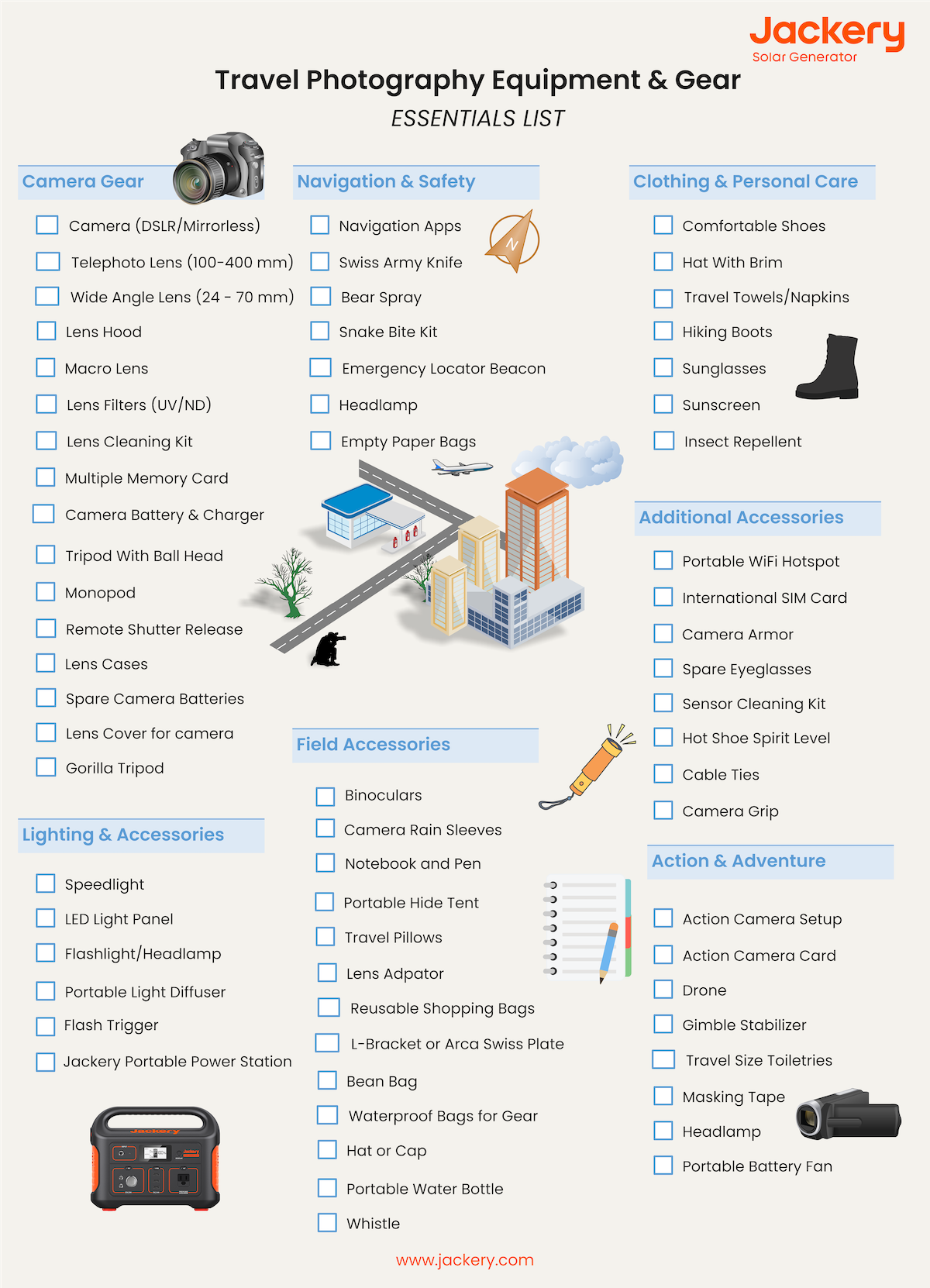
You must consider these vital points when finding the perfect travel camera for your budget, needs, and experience. You might find it challenging to go for just one, but consider how long it takes to charge, how well it's built, and what feels comfortable. So, to help you with that, here are some essential reminders to help you remember when you finally purchase the camera for your travel photography adventures :
Budget
The camera cost can range from a few hundred to thousands of dollars. Even though you want the best photos, traveling carries risks like theft and loss. These are preventable with insurance, but it's essential to remember that the more expensive the camera, the higher the insurance premium will be.
Weight
You won't want a heavy DSLR if you prefer to travel light. Having the most excellent travel camera in your hotel room while you're out having a good time will only do you a little good. A smartphone or compact camera is your best option if you want something that will fit in your pocket or purse.
Purpose
Any type of camera will suffice if your primary objective is to capture beautiful travel images you can add to your albums and post on social media. A mirrorless system will work best if you want a general-purpose camera that can be used for a wide range of travel scenes, such as food photography, landscape photography, or street photography.
Extra Features
These days, many cameras have additional features like touchscreen interfaces, WiFi, GPS built right in, weather resistance, pivoting screens, and more. Regarding actual image quality, the key factors to consider are the sensor size, aperture range, manual control level, and optical zoom on cameras without a lens swap.
Selecting the appropriate camera lens is essential for capturing the ideal shot in any type of photography. Additionally, making the most of the interchangeable lens on your camera can elevate your shots from mediocre to outstanding. Each lens is ideal for only some photographers because everyone has different requirements.
Here are some tips you must consider while choosing the best camera lens for travel photography :
Focal Length
The distance, measured in millimeters, between the sensor and the lens's center when the subject is sharply focused is known as the focal length. The ideal lens for shooting distant subjects is one with a long focal length, preferably greater than 100 mm.
Aperture
The amount of light that can enter your camera is measured by its aperture. The letter f and matching numbers denote it as an f-stop. Wide-aperture lenses (f/2.8 or wider) can produce a beautiful bokeh effect in your photos and are better in low light. A lens with a small aperture number, such as f 1.2, has a wider opening and can capture more light, which makes it ideal for low-light photography.
Prime lens vs. Zoom lens
Zoom lenses are more adaptable because you can change the focal length to capture your subject perfectly. Although prime lenses lack zoom, they usually have wider apertures and produce sharper images. The more you zoom in with a lens, the smaller the maximum aperture.
Compatibility with Sensor
Most DSLR and mirrorless cameras have larger sensors than point-and-shoot cameras, which results in crisper, more lifelike images. Before making any purchases, make sure the lenses you buy for your DSLR or mirrorless camera are compatible with the camera body, as most crop-sensor lenses are designed exclusively with crop-sensor cameras.
Travel Photography Methods: Proactive & Reactive
Compared to other subcategories of photography, travel photography is unique. This genre is very flexible regarding image requirements, but because there are so many obstacles to overcome, it will also put the photographer to the test to the fullest.
There are two major categories for focusing on skill development and preparation : proactive and reactive photography. Street, cultural, and wildlife photography all use reactive photography. Proactive photography is essentially being "proactive" about your next photo shoot by preparing ahead of time.
The proactive photographer still has control over crucial aspects of the situation, even though certain types of photography, such as weddings and events, require a certain level of "reactive" ability to capture. A better photographer will take a proactive approach to photography, which includes positioning the camera with ambient lighting, using fill flash, adjusting the aperture to control depth of field, etc.
Travel Photography Tips & Techniques
Understanding how to "see photographically" allows us to appreciate the world around us on a deeper level. By looking at a scene through a photographic lens, the observer processes it and decides what elements—palette, composition, moment, or combination—pique their interest. Here are some general tips that might help to make your travel photography experience more fruitful:
Know your Equipment
One crucial component of travel photography is being extremely familiar with your gear. Walking on busy streets can expose you to various lighting conditions, and in these fast-paced, ever-changing situations, great opportunities can disappear instantly. Capturing these magical moments requires having the right lens and camera settings ready to react swiftly.
Plan your Shots
Plan out your shot list of pictures you want to take a few hours before you travel to your tourist destinations. Instagram, Google Maps, travel guides, magazines, and other sources are great places to find inspiration. After taking notes, schedule your day with the best times to take photos. Doing this will give you more direction and purpose, which will help you make the shots you want. You should become accustomed to top photographers creating a shot list using social media or Google Maps.
Discover more
One of the best things you can do for travel photography is to set aside some time to spend a day exploring the streets. You'll find places that you otherwise would not have known about. Getting off the beaten path is another excellent method for obtaining genuine and fascinating photos of the culture.
Process your Photos
Take some time during the trip to process your photos as you go rather than wait until the journey's end. This could entail using your laptop for a few hours in a cafe several times a week. Take the time to organize, tag, and rank your photos; it will save you a tonne of work in the future.
Although it's the most challenging aspect for a novice photographer to consider, learning the technical aspects of photography is one of the simplest. It just requires some research and practice. Terms like ISO, aperture, white balance, and shutter speed may appear foreign to you if you have never considered switching your camera from "Auto mode."
Aperture
Aperture size is expressed as numbers and measured in "F Stops" like f 5.6, f 8, f 11, f 16, etc. A wide aperture allows more light to enter than a low aperture and offers a deeper depth of field than a low one.
ISO
ISO refers to the light sensitivity of your camera sensor. A low value, like 100, indicates that it is not highly sensitive and requires more light to make an impact. A photograph with more ISO reveals more noise. In an ideal world, you would want to minimize noise since it degrades the quality of your image.
Shutter Speed
Shutter speed allows you to add motion blur or freeze a frame. Remember that you will need a shutter that is fast enough to compensate for your hand movement if you are holding your camera gear instead of using a tripod. Generally speaking, the slowest you should go to avoid having your picture pick up hand movement is 1/60 of a second. If it's any slower, a tripod is likely necessary.
Manual Mode
Having total control over your settings is the best way to familiarize yourself with your camera and how light works. Shooting in manual mode is the only way to accomplish this. Use aperture priority mode if you need more time to switch to manual.
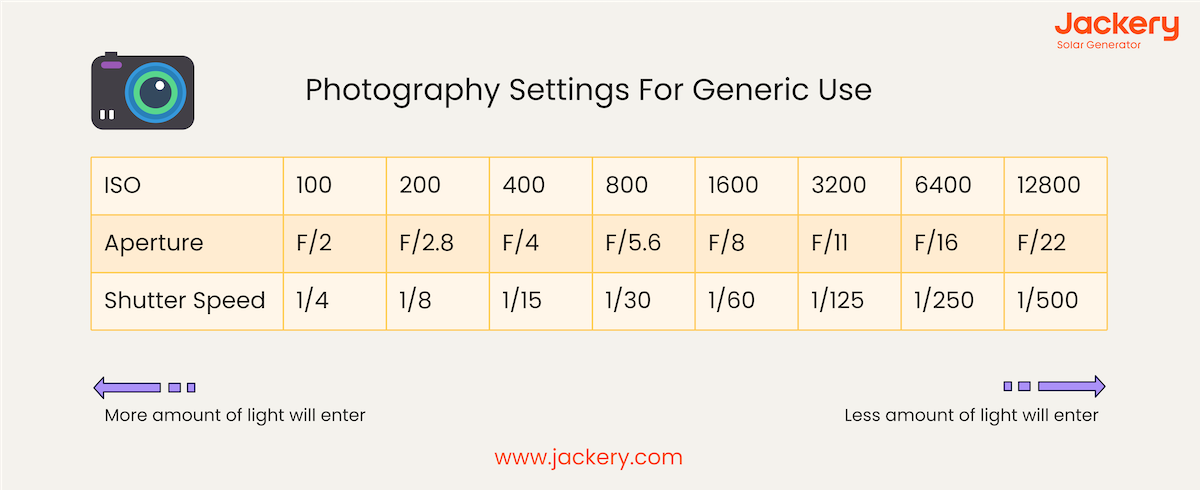
How do Jackery Explorer Portable Power Stations Help with Travel Photography?
Jackery is a leading global brand that aims to provide everyone with green energy. Jackery serves the power needs of all nature lovers, inspiring them to go further and seek out more extraordinary experiences than before. They encourage global adventurers to enjoy the outdoors sustainably, working together to protect the planet.
The Jackery Explorer Portable Power Station can charge your cameras and other travel photography gear with its AC outlet, DC carport, and USB charging ports. It is an ideal power source for your activities, whether traveling with your photography group or needing a backup power supply. Since it is lighter than alternatives, it is simple to carry.
Whether you are shooting in hot summers or freezing winters, the Jackery Explorer Portable Power Stations can work in different temperatures. It also offers a 30 dB quiet renewable power and no fumes. These are portable and built using intelligent BMS and temperature sensors, taking safety to the next level.
Jackery Explorer 500 Portable Power Station
The Jackery Explorer 500 Portable Power Station is lightweight and portable, supporting multiple appliance charging. With a large battery capacity, it is ideal for travel photographers and outdoor adventurers. It offers a versatile outdoor supply and is safe to carry at remote locations for travel photography.
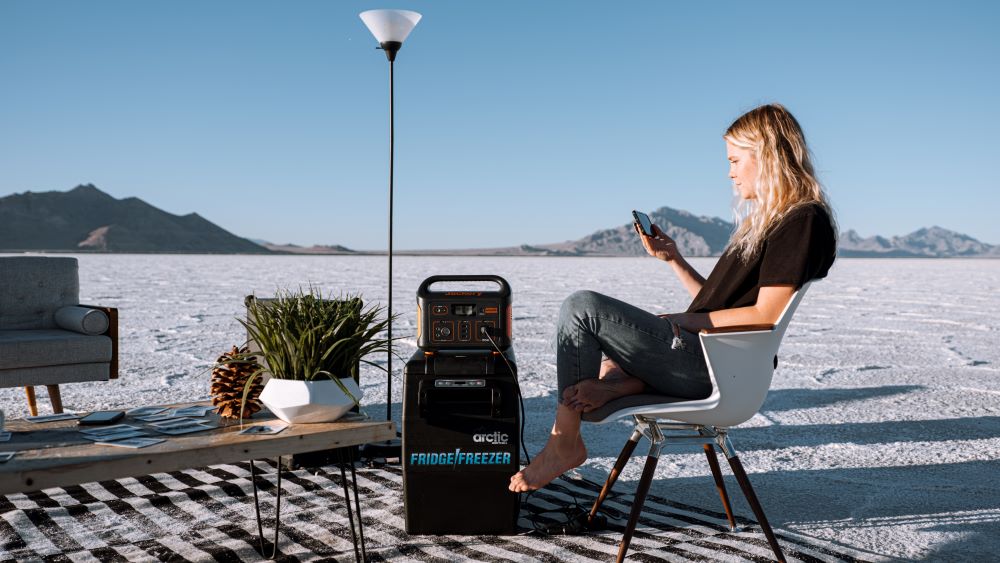
Customer Review
“Way cool. I never knew something like this existed. We do a lot of camping, so I was on this company's site and noticed they have a 1000W. It seems this thing could power my laptop and charge my cameras a zillion times!” — Greg Friedman.
Jackery Explorer 300 Plus Portable Power Station
Weighing only 8.27 lbs, the Jackery Explorer 300 Plus Portable Power Station is ideal for travel photography, road trips, and more. It has dual PD ports with up to 100 W output and offers various charging options for all your camera gear. Its Lithium Iron Phosphate (LiFePO4) Battery ensures the safety of all the gear and kit required for travel photography.
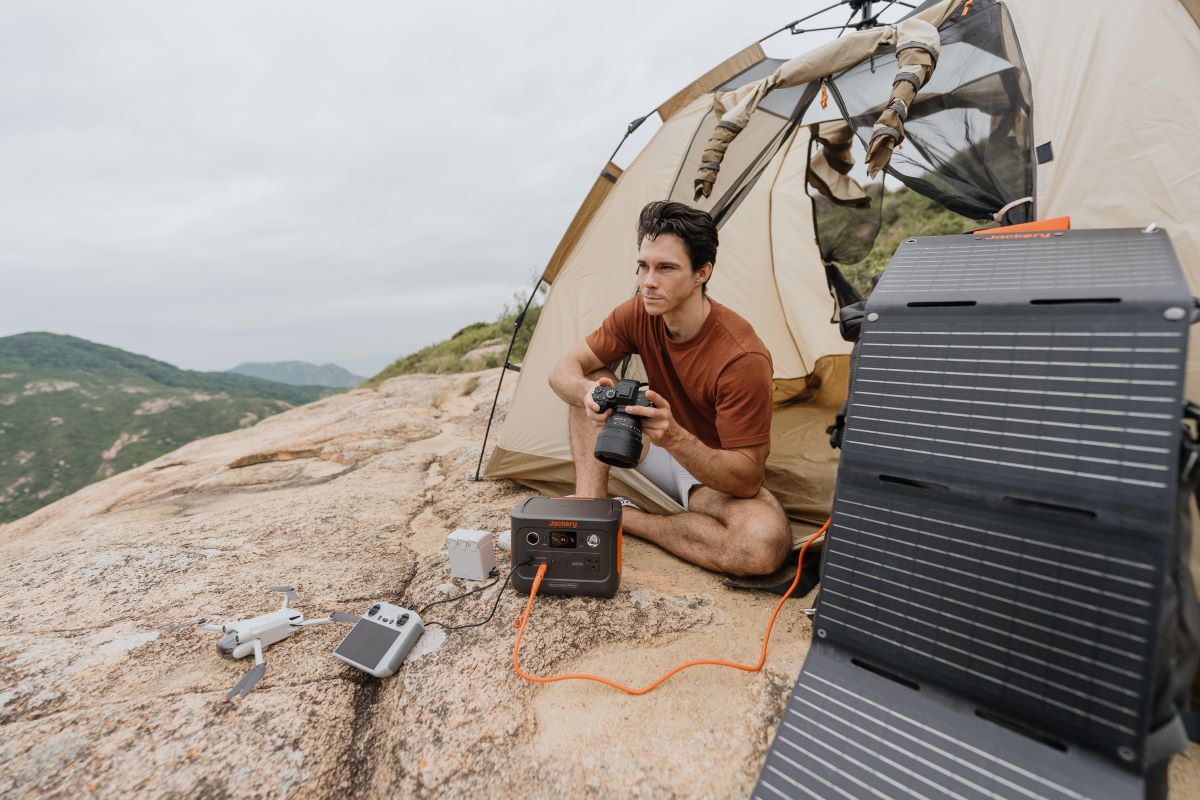
Customer Review
“For the photographers, this is the perfect road trip companion for charging cameras and drones while chewing up the miles between locations. It represents excellent value for the broad range of features and excellent build quality.” — Dan Carr.
|
|
Explorer 500 Portable Power Station |
Explorer 300 Plus Portable Power Station |
|
Capacity |
518 Wh |
288 Wh |
|
Battery Cell |
NMC |
LiFePO4 |
|
Cycle Life |
500 cycles to 80% + capacity |
3000 cycles to 80%+ capacity |
|
Output Ports |
AC Output (x1) : 110 V, 60 Hz, 500 W (1000 W Peak) DC Output (x2) : 12 V⎓7 A USB-A Output (x3) : 5 V⎓2.4 A |
AC Output (x1): 120 V, 60 Hz, 300 W (600 W Peak) USB-A Output (x1): 15 W Max 5 V⎓3 A USB-C Output (x1): 15 W Max 5 V⎓3 A USB-C Output (x2): 100 W Max, 5 V⎓3 A (5 V, 9 V, 12 V, 15 V, 20 V up to 5 A) |
|
Working Hours |
DSLR (60 W) : 7.3 H Mirrorless (50 W) : 8.8 H Action Camera (40 W) : 11 H |
DSLR (60 W) : 4.08 H Mirrorless (50 W) : 4.9 H Action Camera (40 W) : 6.12 H |
Travel Photography FAQs
What size of power station do I need for photography?
Investing in a power station allows you to charge your electronics with clean, renewable energy. However, the exact size of a portable power station required to charge most outdoor appliances is determined by the number of devices and the length of time you want to power them.
For example, a Jackery Explorer 300 Plus Portable Power Station can charge a mirrorless camera (50 W) and a DSLR (70 W).
Working Time = Capacity in Wh × 0.85 / Operating wattage of the appliances.
So, Working time = 288 Wh × 0.85 / 120 W = 2.04 H.
The efficiency rate is 0.85 since there will be some power loss while charging appliances with the portable power station.
What is considered travel photography?
Taking pictures while traveling is known as travel photography, and it encompasses a wide range of photographic specialties, including street, architectural, food, landscape, and adventure photography.
How much do you get paid to be a traveling photographer?
On average, travel photographers typically make USD 45,581 a year. A photographer can charge on a per-hour basis for travel photography.
Are travel photographers in demand?
Whether you photograph destinations for editorial or commercial clients or pursue other revenue streams, travel-related brands such as hotels and destinations are constantly searching for new travel photographers.
How hard is it to become a travel photographer?
It takes a lot of work to turn a hobby like photography into a career and become a digital nomad. Travel photographers who work for themselves must have a strong sense of purpose and be completely dedicated to their work.
Final Thoughts
Travel photography is an exciting mixture of inventiveness, adventure, and narration. It acts as a passage to different cultures, stunning scenery, and memories that will never fade from one’s mind. One can capture moments that motivate, enlighten, and transcend borders by embracing proactive and reactive approaches, acquiring technical skills in photography, and using renewable energy solutions like Jackery Explorer Portable Power Stations. Thus, by studying for enhancement in addition to training alone, there are no limits when it comes to expression through travel photography.
Learning Resources
The Enthusiast's Guide to Travel Photography: 55 Photographic Principles You Need to Know - Book
The Travel Photography Book
Travel and Street Photography - PDF



















































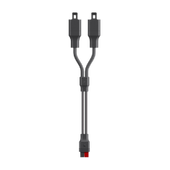

















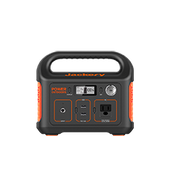










































Leave a comment